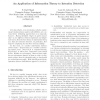Free Online Productivity Tools
i2Speak
i2Symbol
i2OCR
iTex2Img
iWeb2Print
iWeb2Shot
i2Type
iPdf2Split
iPdf2Merge
i2Bopomofo
i2Arabic
i2Style
i2Image
i2PDF
iLatex2Rtf
Sci2ools
142
Voted
IWIA
2006
IEEE
2006
IEEE
An Application of Information Theory to Intrusion Detection
Zero-day attacks, new (anomalous) attacks exploiting previously unknown system vulnerabilities, are a serious threat. Defending against them is no easy task, however. Having identified “degree of system knowledge” as one difference between legitimate and illegitimate users, theorists have drawn on information theory as a basis for intrusion detection. In particular, Kolmogorov complexity (K) has been used successfully. In this work, we consider information distance (Observed K − Expected K) as a method of detecting system scans. Observed K is computed directly, Expected K is taken from compression tests shared herein. Results are encouraging. Observed scan traffic has an information distance at least an order of magnitude greater than the threshold value we determined for normal Internet traffic. With 320 KB packet blocks, separation between distributions appears to exceed 4σ.
Related Content
| Added | 12 Jun 2010 |
| Updated | 12 Jun 2010 |
| Type | Conference |
| Year | 2006 |
| Where | IWIA |
| Authors | E. Earl Eiland, Lorie M. Liebrock |
Comments (0)

